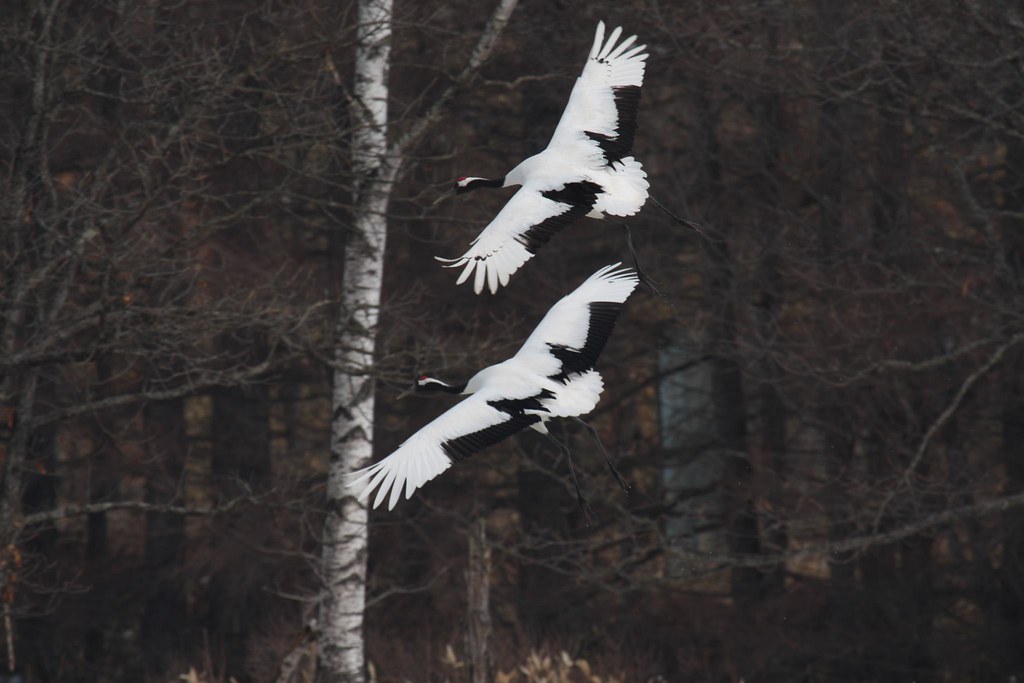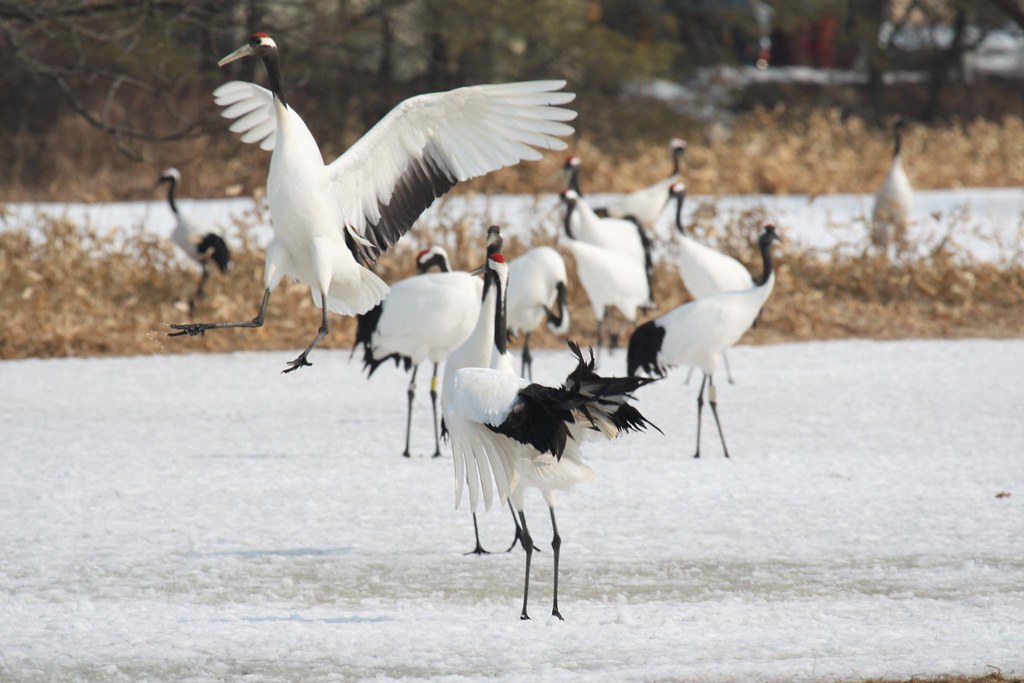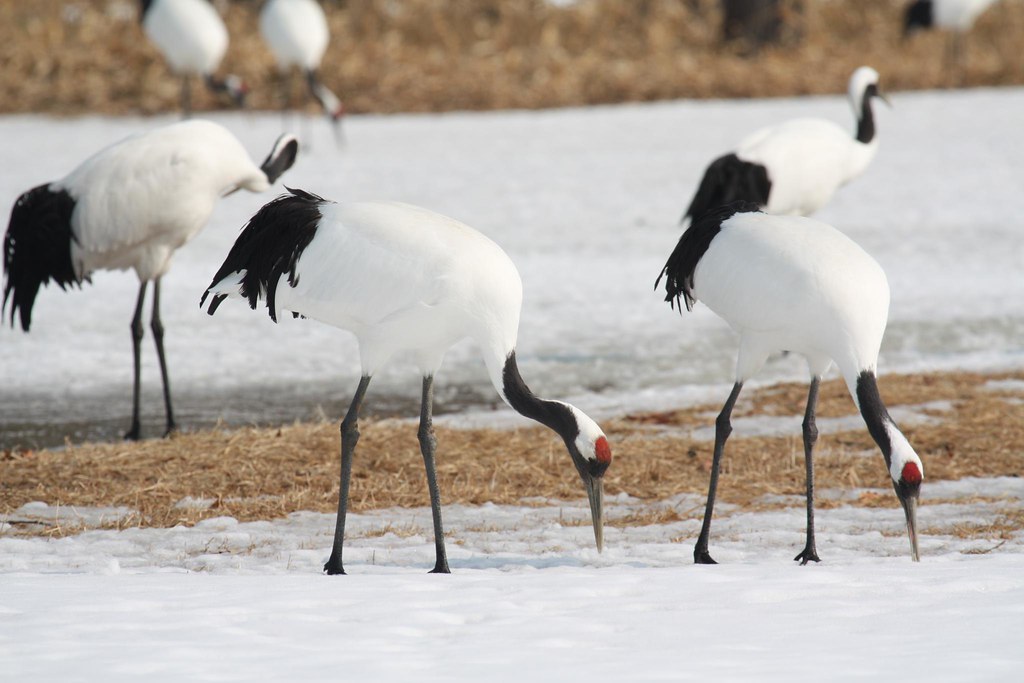.

Two Red-crowned Cranes, also called the Japanese Crane or Manchurian Crane (Grus japonensis), flying in Hokkaido, Japan: photo by Alastair Rae, 25 February 2011
.....The crane screeches:
At its voice
.....The bashô will surely tear.
Bashô, in R. H. Blyth: Haiku, Volume IV: Autumn-Winter, Tokyo, 1951
This is an early haiku of Bashô. He has attempted here to resolve into one, sound and sight and texture, the voice of the bird and the rending of the broad leaves of the banana-plant. This verse was actually written for and on a picture, evidently of a crane and a banana-plant. Bashô imagines this bird suddenly crying out; at its harsh, strident note the tenderly brittle leaf of the plant will slit like calico. -- Blyth
This is an early haiku of Bashô. He has attempted here to resolve into one, sound and sight and texture, the voice of the bird and the rending of the broad leaves of the banana-plant. This verse was actually written for and on a picture, evidently of a crane and a banana-plant. Bashô imagines this bird suddenly crying out; at its harsh, strident note the tenderly brittle leaf of the plant will slit like calico. -- Blyth

Several Red-crowned Cranes, also called the Japanese Crane or Manchurian Crane (Grus japonensis), in snow at Hokkaido, Japan: photo by Alastair Rae, 25 February 2011

Several Red-crowned Cranes, also called the Japanese Crane or Manchurian Crane (Grus japonensis) in Hokkaido, Japan: photo by Alastair Rae, 25 February 2011

Red-crowned Crane aka Manchurian Crane (Grus japonenis), in flight at Akan International Crane Center, Hokkaido, Japan: photo by Spaceaero2, 13 February 2007
Grus japonensis in snow,
Tsurumidai, Tsurui-mura, Hokkaido, Japan: photo by ほくなん, 2 January 2006

A Red-crowned Crane, also called the Japanese Crane or Manchurian Crane (Grus japonensis), flying in Hokkaido, Japan: photo by Alastair Rae, 25 February 2011

Manchurian Cranes, Hokkaido, Japan: photo by Hiyashi Haka, 25 June 2012

Red-Crowned Cranes (Grus japonensis) breeding, Xianghai, Manchuria, China: photo by Gunnar Petterson, 9 May 2011

The Dance of the Red-Crowned Cranes is marvelous to contemplate. These creatures have got some hops. And after the hops... at 2:43 one can hear that leaf-shredding call.
ReplyDeleteGrus japonensis is a majestic creature still -- among the largest of cranes, often exceeding five feet in height and four feet in length, from bill to tail tip -- yet also, now, an increasingly endangered one.
Once great flocks of Red-crowned Cranes filled the skies across northern Asia. Today the estimated total population of the species is only some 2,750 in the wild. Of the remaining migratory populations, about one-third winter in China (mainly at the Yellow River Delta and Yancheng Coastal Wetlands), the rest in Korea. In spring and summer, the migratory populations breed in Siberia, northeastern China and in protected areas in northeastern Mongolia. The breeding range centers in Lake Khanka, on the Sino-Russian border.
Normally the female lays two eggs, with only one surviving. Later, in the fall, the flocks migrate to Korea and east-central China to spend the winter. The most significant non-migratory population, consisting of about a thousand birds, resides in eastern Hokkaido in Japan.
The species nests in wetlands and rivers. In the wintering range, its habitat is comprised mainly of paddy fields, grassy tidal flats, and mudflats. In the flats, the birds feed on aquatic invertebrates; in cold, snowy conditions, they must make do with rice gleanings from the paddy fields.
In Japan, Grus japonensis is known as the tancho and is said to live a thousand years.
Historically the great graceful bird with the red crown has held a prominent place in the poetry of several Asian cultures.
That of Bashô is but one.
The title of this post evokes the Red-crowned Crane's particular history and significance in Taoist poetics. During the Han period in China, Taoism assumed aspects of magic. Legends arose that Taoist masters had learned to extend their lives indefinitely, to fly through the clouds, to become invisible. Alchemists and magicians streamed into the Han courts, where they attempted to refine crass material substances in the effort to secure eternal life. From the imagery in Taoist poetry, these wizards created a complex symbolism based on red. The holy color red represented the alchemical furnace and its beautiful, red-robed patron goddess. A common talisman was the Manchurian Crane, symbol of longevity with the red spot of divinity on its crown. Hand-in-hand with the reputation for longevity (not quite accurate, in fact, as the individual birds survive only three or four years) went a legendary association with immortality.
Tom,
ReplyDeleteSuch beautiful birds, and those cries -- Basho is right, leaves would tear.
12.8
light coming into sky above black plane
of ridge, jet passing above pine branch
in foreground, wave sounding in channel
that this since which while
would be, to be of it
shows that at the same time,
each its own, as such
waning white moon in blue white of sky,
wingspan of gull flapping toward point
Steve,
ReplyDeleteThanks for bringing the cranes some aerial company,
at the same time,
each its own, as such
waning white moon in blue white of sky,
wingspan of gull flapping toward point
The poem seems to carry a delight in its fragility, the thought of its own wounding.
ReplyDeleteStephen's right - these are beautiful birds.
love the birds and haiku...!
ReplyDeleteGenius flies
ReplyDeleteancient with feathers
to rest in the next
place to rest in snow
something with a stong sound
pulled away from form
left with red against it.
Careful, careful
ReplyDeletewatching this quiet
snow place formed
by grey, red, black
sounds across.
"will surely tear"
ReplyDeletebut did not quite
yet
that beautiful miss
the future the minute
it lasts